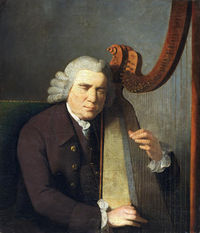Annotation:Nos Galan: Difference between revisions
No edit summary |
m (Text replacement - "garamond, serif" to "sans-serif") |
||
| Line 1: | Line 1: | ||
=='''Back to [[{{BASEPAGENAME}}]]'''== | =='''Back to [[{{BASEPAGENAME}}]]'''== | ||
---- | ---- | ||
<p><font face=" | <p><font face="sans-serif" size="4"> | ||
'''NOS GALAN''' (New Year's Eve). AKA - "New Years Gift," "Nôs Galan." Welsh, Air (2/4 time). F Major. Standard tuning (fiddle). AAB. This Welsh harp tune fist appears in John ("Blind Parry of Ruabon") Parry's (c. 1710-1782) '''Twelve Airs for One and Two Guitars''', 1781 edition (where it is an untitled air). It was followed by a printing in Edward Jones's (Bardd y Brenin) '''Musical and Poetical Relicks of the Welsh Bards''' (1784, p. 159) who gave it the name "Nos Galan," with a lyric in English and Welsh (that seems to have little to do with the holiday). It is ancestral or a precursor to the air for the familiar Christmas carol "Deck the Halls," but originally was a dance tune, the melody providing the musical vehicle for dancers who would circle around, improvising spontaneous lyrics (with the harp playing the tag melody that is now sung as "Fa-la-la-la-la". In the 19th century other lyrics were added. | '''NOS GALAN''' (New Year's Eve). AKA - "New Years Gift," "Nôs Galan." Welsh, Air (2/4 time). F Major. Standard tuning (fiddle). AAB. This Welsh harp tune fist appears in John ("Blind Parry of Ruabon") Parry's (c. 1710-1782) '''Twelve Airs for One and Two Guitars''', 1781 edition (where it is an untitled air). It was followed by a printing in Edward Jones's (Bardd y Brenin) '''Musical and Poetical Relicks of the Welsh Bards''' (1784, p. 159) who gave it the name "Nos Galan," with a lyric in English and Welsh (that seems to have little to do with the holiday). It is ancestral or a precursor to the air for the familiar Christmas carol "Deck the Halls," but originally was a dance tune, the melody providing the musical vehicle for dancers who would circle around, improvising spontaneous lyrics (with the harp playing the tag melody that is now sung as "Fa-la-la-la-la". In the 19th century other lyrics were added. | ||
[[File:parry.jpeg|200px|thumb|left|John Parry, painted by his son, William Parry (1742–1791)]] The tune also accompanies the Welsh dance "Dawns Flodau Nantgarw." | [[File:parry.jpeg|200px|thumb|left|John Parry, painted by his son, William Parry (1742–1791)]] The tune also accompanies the Welsh dance "Dawns Flodau Nantgarw." | ||
| Line 7: | Line 7: | ||
<br> | <br> | ||
</font></p> | </font></p> | ||
<p><font face=" | <p><font face="sans-serif" size="4"> | ||
''Source for notated version'': | ''Source for notated version'': | ||
<br> | <br> | ||
<br> | <br> | ||
</font></p> | </font></p> | ||
<p><font face=" | <p><font face="sans-serif" size="4"> | ||
''Printed sources'': William Bingley ('''North Wales...delineated from two excursions, vol. 2'''), 1804; p. 9. | ''Printed sources'': William Bingley ('''North Wales...delineated from two excursions, vol. 2'''), 1804; p. 9. | ||
<br> | <br> | ||
<br> | <br> | ||
</font></p> | </font></p> | ||
<p><font face=" | <p><font face="sans-serif" size="4"> | ||
''Recorded sources'': <font color=teal></font> | ''Recorded sources'': <font color=teal></font> | ||
</font></p> | </font></p> | ||
Revision as of 14:30, 6 May 2019
Back to Nos Galan
NOS GALAN (New Year's Eve). AKA - "New Years Gift," "Nôs Galan." Welsh, Air (2/4 time). F Major. Standard tuning (fiddle). AAB. This Welsh harp tune fist appears in John ("Blind Parry of Ruabon") Parry's (c. 1710-1782) Twelve Airs for One and Two Guitars, 1781 edition (where it is an untitled air). It was followed by a printing in Edward Jones's (Bardd y Brenin) Musical and Poetical Relicks of the Welsh Bards (1784, p. 159) who gave it the name "Nos Galan," with a lyric in English and Welsh (that seems to have little to do with the holiday). It is ancestral or a precursor to the air for the familiar Christmas carol "Deck the Halls," but originally was a dance tune, the melody providing the musical vehicle for dancers who would circle around, improvising spontaneous lyrics (with the harp playing the tag melody that is now sung as "Fa-la-la-la-la". In the 19th century other lyrics were added.

The tune also accompanies the Welsh dance "Dawns Flodau Nantgarw."
Source for notated version:
Printed sources: William Bingley (North Wales...delineated from two excursions, vol. 2), 1804; p. 9.
Recorded sources:
